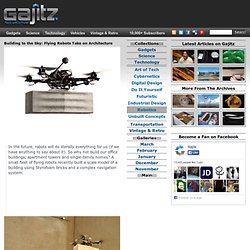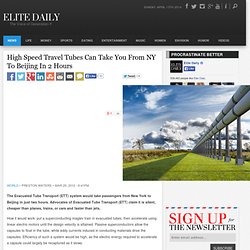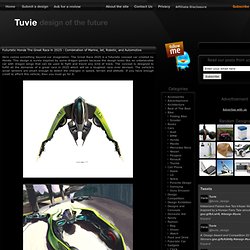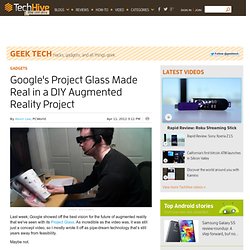

Building to the Sky: Flying Robots Take on Architecture. In the future, robots will do literally everything for us (if we have anything to say about it).

So why not build our office buildings, apartment towers and single-family homes? A small fleet of flying robots recently built a scale model of a building using Styrofoam bricks and a complex navigation system. Conceived by a team of architects, the Flight-Assembled Architecture project was an exercise in design and in technology. The small quadrocopters were programmed with the coordinates of the room they were in and the locations of the bricks they were expected to put into place.
Then, without any further intervention, the ‘bots built a six-meter-high structure one brick at a time. The tiny team of robots built their unusual structure at the FRAC Center in Paris before an amused crowd in December 2011. High Speed Travel Tubes Can Take You From NY To Beijing In 2 Hours. The Evacuated Tube Transport (ETT) system would take passengers from New York to Beijing in just two hours.

Advocates of Evacuated Tube Transport (ETT) claim it is silent, cheaper than planes, trains, or cars and faster than jets. National Ignition Facility & Photon Science - Bringing Star Power to Earth. The National Ignition Facility Aims to Create a Mini Star. World, meet the National Ignition Facility: a massive and incredible research device to study (and create) controlled nuclear fusion.

Containing the world’s largest and highest-energy laser, the facility hopes to create the first controlled thermonuclear reaction ever. If they succeed, they will have achieved a dream of physics that many claimed impossible: man-made fusion as a source of energy. A mini star. Happy Friday. Inside the target chamber. Today marks the opening ceremony, with big names like Energy Secretary Steven Chu, laser pioneer Charles Hunt Townes, and even the Governator in attendance. So how does one go about creating a mini star? Time to Get Some Superpowers. Futuristic Honda The Great Race in 2025 : Combination of Marine, Jet, Robotic, and Automotive.
Here comes something beyond our imagination.

The Great Race 2025 is a futuristic concept car created by Honda. This design is surely inspired by some dragon games because the design looks like an unbelievable car with dragon wings that can be used to fight and travel any kind of track. The concept is designed to fulfill all the demands of a great race in 2025 which will be a toughest race ever devised. The vehicle’s sonar sensors are smart enough to detect the changes in speed, terrain and altitude. If you have enough credit to afford this vehicle, then you must go for it.
Text from designer : In 1908, 17 men dared to take on the “toughest race ever devised.” Competitors must circumnavigate the globe in 24 hours on land through the United States, by sea through Asia and by air over Europe. Researchers claim quantum breakthrough › News in Science (ABC Science) News in Science Thursday, 26 April 2012 Connor Duffy and staffABC Giant leap Researchers say they have designed a tiny crystal that acts like a quantum computer so powerful it would take a computer the size of the known universe to match it.

Details of the crystal, which is made up of just 300 atoms, are published today in the journal Nature. "Quantum computing is a kind of information science that is based on the notion that if one performs computations in a fundamentally different way than the way your classical desktop computer works," says study co-author University of Sydney's Dr Michael Biercuk. "There's a huge potential to solve a variety of problems that are very, very hard or near impossible for standard computer. " LED Lights Make Augmented Vision a Reality. LED Lights Make Augmented Vision a Reality Okay, this is just freaky.

We know LED lights are versatile enough to be used for practically anything, but LED contact lenses? Really?! Yes, as it turns out, really. University of Washington researchers have figured out how to implant semitransparent red and blue LED lights in contact lenses, for the purpose of receiving and displaying data in sharp visual images and video.
Once miniature green LEDs are developed (and they’re in the works, as of now), full color displays will be possible. Lead researcher Babak Parvis comments “You won’t necessarily have to shift your focus to see the image generated by the contact lens,” it would just appear in front of you and your view of the real world will be completely unobstructed when the display is turned off. Ah, the real world. Thanks to Extreme Tech for the quote and Trendhunter for the images. Project Glass: One day... Google's Project Glass Made Real in a DIY Augmented Reality Project. Last week, Google showed off the best vision for the future of augmented reality that we've seen with its Project Glass.

As incredible as the video was, it was still just a concept video, so I mostly wrote it off as pipe-dream technology that’s still years away from feasibility. Maybe not. Will Powell, an AR developer from Oxford, built his own DIY version of Project Glass. iRobot Unveils Morphing Blob Robot (w/ Video)